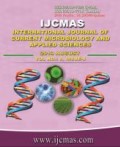


 National Academy of Agricultural Sciences (NAAS)
National Academy of Agricultural Sciences (NAAS)

|
PRINT ISSN : 2319-7692
Online ISSN : 2319-7706 Issues : 12 per year Publisher : Excellent Publishers Email : editorijcmas@gmail.com / submit@ijcmas.com Editor-in-chief: Dr.M.Prakash Index Copernicus ICV 2018: 95.39 NAAS RATING 2020: 5.38 |
Field experiments were conducted to study the effect of sowing techniques and seed rate on growth and yield of direct seeded rice (Oryza sativa L.) under rainfed medium land situation. The experiment consists of two sowing techniques (Broadcasting and Line sowing) with five seed rate (80 kg ha-1, 90 kg ha-1, 100 kg ha-1, 110 kg ha-1 and 120 kg ha-1) and replicated thrice in factorial randomised block design. Line sowing with seed rate of 100 kg ha-1 was found to be superior (6030 kg ha-1) in grain production over the other combinations. Maximum plant height (112.29 cm), number of tillers m-2 (90.40), effective tillers m-2 (85.60) and panicle length (26.93 cm) were recorded from line sowing (S2) and it was significantly higher than the plant height (111.71 cm), number of tillers m-2 (88.40), effective tillers m-2 (82.80) and panicle length (25.80) obtained from the broadcasting (S1). At the time of harvesting maximum plant population m-2 (46.87) was recorded from the line sowing (S2) and the lowest (45.53) from broadcasting (S1). At harvest plant height (112.92 cm) observed from the seed rate of 120 kg ha-1 (R5) was found to be significantly higher than the rest seed rates. The number of effective tillers/ m2 (89.17) and panicle length (27.67 cm) were observed from the seed rate of 100 kg ha-1 (R3) which was significantly higher than other seed rates. Test weight was not influenced significantly by the sowing technique as well as seed rate.
 |
 |
 |
 |
 |